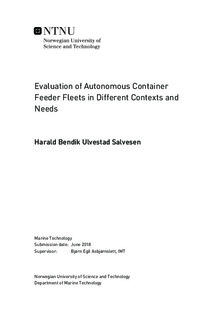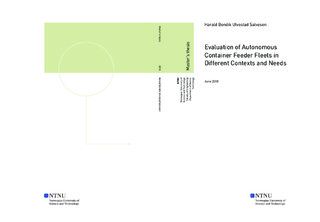| dc.description.abstract | Unmanned autonomous ships are a popular subject in recent maritime research and innovation studies. Autonomy in shipping bears the potential to reduce the environmental impact, increase safety and reduce costs. So far, minimal attention has been devoted to the potential cost benefits of autonomous shipping. From a ship owner's perspective the main determinant of autonomous shipping rely on the economic viability. Ship acquisition involve a large capital investment, and the future operating context is highly uncertain. The maritime industry is characterized by uncertain exogenous factors that affect operational costs.
The overall objective of this thesis is to compare autonomous container feeder fleets to conventional feeder fleets in terms of costs. In order to investigate potential cost-benefits of autonomy, the required infrastructure and technical systems are identified. The costs changes that occur for autonomous vessels are estimated using approximation methods with a conventional container vessel as reference. Operational costs and voyage costs are determined by solving a multi-trip Vehicle Routing Problem for a specific regional Baltic container trade. Contextual uncertainties are considered using the Responsive Systems Comparison method together with Multi-Epoch Analysis.
The results from the analysis show that autonomous container fleets have lower costs than conventional container fleets in a variety of different contexts. In a base case scenario the cost of the optimal autonomous fleet is USD 1.39 million lower than for optimal the conventional fleet. However, the results from the analysis are related with a high degree of uncertainty. The uncertainties are primarily due to the conceptual state of autonomy in container shipping, and limited access to precise cost data for autonomous vessels. It turned out to be challenging to capture the difference between autonomous and conventional vessels using the Responsive Systems Comparison method. Eventually, the method acted more like a sensitivity analysis. However, in a future scenario when autonomous shipping is more developed, the overall approach can serve as a powerful tool for fleet evaluation. | |

